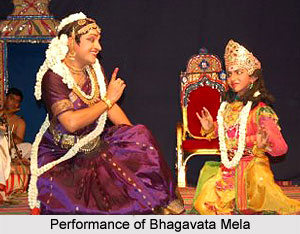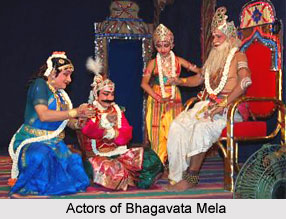 Bhagavata mela is a form of dance drama. Dance drama or Natya, according to the Sahityadarpana, is a "poem made visible". Indian Natya has a poetic form and is acted in a rhythmic manner. Just as poetry differs from natural speech, so Natya differs from natural actions. Lokadharma refers to that which is realistic and popular Natyadharma means that which is conventional, and governed by codes and formalities.
Bhagavata mela is a form of dance drama. Dance drama or Natya, according to the Sahityadarpana, is a "poem made visible". Indian Natya has a poetic form and is acted in a rhythmic manner. Just as poetry differs from natural speech, so Natya differs from natural actions. Lokadharma refers to that which is realistic and popular Natyadharma means that which is conventional, and governed by codes and formalities.
Indian theatre or Natya had its origin in expository dance. The first actor, Nata, was an actor-dancer who portrayed dramatic incidents by means of gesture and dance, with song and musical accompaniment. The Natyashastra states that drama must contain Nritya (expository dance), Geeta (song), and Vadya (instrumental accompaniment). Indian drama gives importance to gesture in place of the spoken word. It is meant to be seen by the spectator rather than heard. Very little of this glorious dramatic art is now to be seen. The Sanskrit theatre is a hereditary art of the Chakkiyars of Kerala temples, a source of Kathakali dance drama in Malayalam language. The vernacular drama also survives in Andhra Pradesh in the Kuchipudi dance drama of Brahmin Bhagavatas; the Bhagavata Mela Natya in the Tanjore district of Tamil Nadu, and the Yakshagana in Karnataka on the West coast.
Actors of Bhagavata Mela
 In a small village called Kuchipudi on the Krishna River in Andhra Pradesh, the Kuchipudi Bhagavatars, Brahmin actors, have handed down their classical dances and dance dramas for generations, and are well versed in the classical gesture language and dramatic dance modes of Kuchipudi Natya, in Telugu language. Their dramas are staged at night in the open air, some of the favourite plays being Usha Kalyanam, Prahalad, and Bhama-kalapam. Preliminary invocation prayers describe the ten incarnations of Lord Vishnu in verses, which are beautifully acted in abhinaya and danced with vivid postures and gestures. A stage curtain is held up in front of the actors and lighting is provided by torches. All roles are acted by men, who take both male and female parts. Each actor introduces himself with a draw, a special elaborate entrance dance, containing postures, steps and gestures, and various dance patterns. There are feminine and masculine types, accompanied by song and rhythmic syllables.
In a small village called Kuchipudi on the Krishna River in Andhra Pradesh, the Kuchipudi Bhagavatars, Brahmin actors, have handed down their classical dances and dance dramas for generations, and are well versed in the classical gesture language and dramatic dance modes of Kuchipudi Natya, in Telugu language. Their dramas are staged at night in the open air, some of the favourite plays being Usha Kalyanam, Prahalad, and Bhama-kalapam. Preliminary invocation prayers describe the ten incarnations of Lord Vishnu in verses, which are beautifully acted in abhinaya and danced with vivid postures and gestures. A stage curtain is held up in front of the actors and lighting is provided by torches. All roles are acted by men, who take both male and female parts. Each actor introduces himself with a draw, a special elaborate entrance dance, containing postures, steps and gestures, and various dance patterns. There are feminine and masculine types, accompanied by song and rhythmic syllables.
The Gita Govinda of Jayadeva is one of the masterpieces of Kuchipudi abhinaya in classical style. Kuchipudi dance is related to Devadasi Nritya in fundamental technique and gestures, and is one of several parallel traditions of the art in South India. Vachika abhinaya (speech) has a place in South Indian Natya though the balance between speech, gesture, songs, and dance is well established in Kuchipudi Natya. In the Tanjore district Natya is performed at the Vasanta Utsavam of Lord Vishnu in Melatur and Soolamangalam. About 160 years ago, a sage, Venkatramaswamigal of Melatur in Tanjore composed a number of religious dramas Usha Kalyanam, Prahlad, Bhama-kalapam, Rukmini Kalyanam, Markandeya and others, in Telugu, the art language of South India. They were dramatic poems set to music, for dancing and acting in the traditional manner. Bhagavata Mela Natya, as the art is called, is performed by Brahmin actors who are experts in singing, dancing and gestures. The daru or entrance dance of each principal actor is elaborate in rhythmic style and rendered with grace and elegance. Dances similar to alarippu, varnam, and padam, with adavujatis (dance patterns) and Uramanas (final sequences) are fundamentally related to Bharatnatyam of the Devadasis. But there are both masculine and feminine dance patterns which are significant for further development of Bharatnatyam into a dramatic form. Fundamental similarities are noticeable in the Melatur and Kuchipudi dance drama which suggest a common origin. What the Devadasis have learned from the non-Brahmin Nattuvans is only a part of a great dance art current among several groups of hereditary experts.
The Vasanta Utsava was not celebrated with Natya for nine years due to financial difficulties in staging the plays. There are very few of the actors left to maintain the art, though the dramas have lately been performed. Within ten years, both Kuchipudi and Bhagavata Mela Natya will be lost arts in India, since the practise of Natya Kala will end with the present old masters. Their sons will not learn an art for which there is little appreciation and no economic security.
On the West coast in South Karnataka there are seasonal performances of Yakshagana dance-dramas. The actors are very clever in improvised speech, and the various intonations and inflections are derived from the Natyashastra traditions.




















